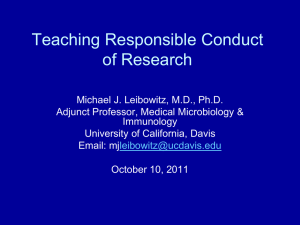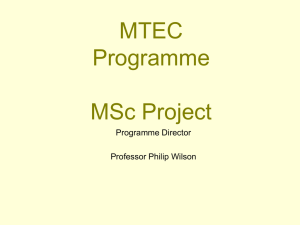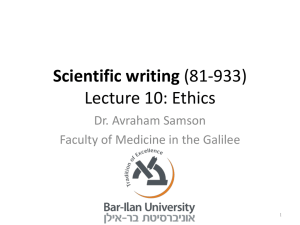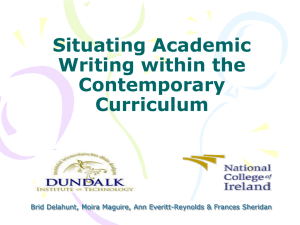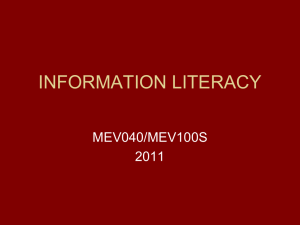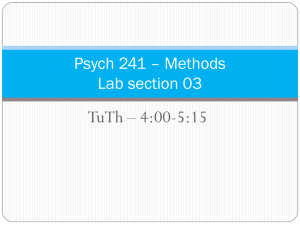Student Presentation - Savannah State University
advertisement
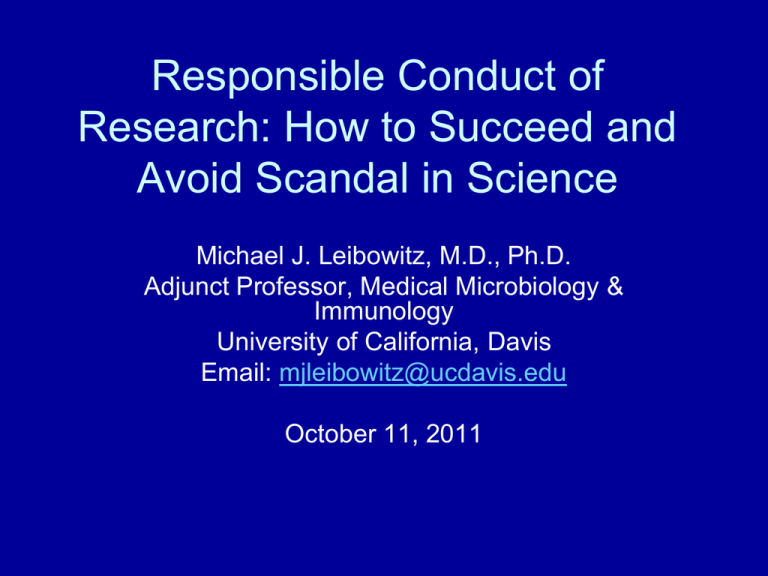
Responsible Conduct of Research: How to Succeed and Avoid Scandal in Science Michael J. Leibowitz, M.D., Ph.D. Adjunct Professor, Medical Microbiology & Immunology University of California, Davis Email: mjleibowitz@ucdavis.edu October 11, 2011 Why Responsible Conduct of Research • Scientists depend on prior data (not conclusions) • Public trust required • Misconduct (even inadvertent) can end a scientific career • Biomedical research: Lives are at stake • US Public Health Service requires RCR training at every step of scientific development Definition of Scientific Misconduct • • • • Fabrication Falsification Plagiarism Other definitions (not meeting the standards of the scientific community) no longer widely used …in proposing, performing, or reviewing research, or in reporting research results. Definition of Research Research means a systematic investigation, including research development, testing, and evaluation, designed to develop or contribute to generalizable knowledge. • Not clinical practice, even if trying an unproven treatment • Not program or course evaluation (unless plan to publish results) • Not teaching a course (even if scientific) Experimental Data • • • • • Who owns them? Dated and signed Not removable or erasable How keep computerized data? Data are needed for publications, patents and to defend against charges of misconduct, and most importantly, in order to repeat or trouble-shoot experiments Publishing a Paper • • • • • • • • • • Why publish? When you ready to publish? Who should be an author? What is your responsibility? How do you avoid plagiarizing? Where to submit? Who reviews? What to expect from peer review? How to respond to reviewer critiques? What are your responsibilities as a reviewer? Publishing a Paper • Authorship is the “coin of the realm” • When you ready to publish? Tell a complete story, reproducible data, significant contribution • Author/contributor: significant contribution to the design, experimentation, and reporting of the work; DECIDE EARLY • Rewards and responsibilities of authorship: credit and blame • New initiative to identify contribution of each contributor (not exactly same as author) of a paper (Rennie et al., JAMA 278:579, 1997) Fabrication and Falsification • Unlike plagiarism, obviously wrong and requires conscious action by the wrongdoer • How can this be prevented? -Supervisors -Reviewers -Other researchers Falsification and Fabrication • Is it ever possible to omit data from analysis? • Must all data be published? Data Selection and Retention CASE A2 Alan Yeager has completed a series of experiments characterizing the receptor for a new class of hormones. During the course of his work, he studied binding characteristics and hormonal responses in tissue culture and in vitro, utilizing gels to characterize the molecular weights of receptor variants. This was exciting work for a second-year graduate student doing his first project. One day, Alan's laboratory chief asked him to prepare an abstract for an upcoming meeting and a paper for publication, both to be based on the work Alan had been doing. The abstract was due in one week. As Alan examined his accumulated data, he noted that a number of cell culture plates failed to respond to the hormonal stimulus and that there was considerable variability in the dose-response relationship. His data are represented in Figure 1. Figure 1 Furthermore, on reexamination, he noted that a number of his gels were not very aesthetic in appearance, yet he was sure that they demonstrated the molecular weight, agonist binding, and subunit characteristics of the receptor. Alan mentioned his distress to Pam Alden, a fifth-year graduate student, who said, "Why don't you clean up your data? You'll never get the paper published unless you do. We always clean up the data around here. "She then suggested that the four culture points failing to show a response (along the X-axis at the 0 nanomolar concentration) be dropped because the cells were probably dead. She also pointed out that he might eliminate the top data point at the 45 minute interval as an outlier. She examined the gels and suggested retouching the negatives from which the prints were to be made, including the duplication of one of the nicer gel lanes to replace another that turned out poorly, but showed essentially the same result. "That will greatly improve your chances of publication," she said. Alan replied, "Maybe I should repeat a few of the experiments or try to improve the culture conditions?" “No,” said Pam, "if you're convinced of your results, why go through the time, expense, and uncertainty of more repetitions? You'll never complete an experiment in time for the abstract, anyhow.” Somewhat dismayed, Alan thanked her and turned back to his work. CASE A2 Questions 1. What do you think about Pam's comments on publication practices and her suggestions for "cleaning up" the data? 2. How should Alan go about determining which points to include and which to exclude? 3. What other course(s) of action would you recommend to Alan? 4. Pam's perception about improving the chances of publication by "cleaning up" the data is not uncommon. How might journal editors and reviewers work toward correcting this perception? S.G. Korenman and A.C. Shipp, Teaching the Responsible Conduct of Research through a Case Study Approach: A Handbook for Instructors, Association of American Medical Colleges, Washington, DC, 1994. Definition: Plagiarize • “to steal or pass off as one’s own (the ideas or words of another)” • “to present as one’s own an idea or product derived from an existing source.” Webster’s Seventh New Collegiate Dictionary Definition: Copyright • “the exclusive legal right to reproduce, publish and sell the matter and form of a literary, musical or artistic work.” • Note that this includes scientific publications. Webster’s Seventh New Collegiate Dictionary Who owns a publication? • • • • • • All authors? Senior (first) author? Submitting (PI) author? Employer(s) of authors? Funding agencies? Publisher? Why is plagiarism the most widespread infraction despite being the easiest to detect? • Many authors may not know the rules! • Computers make plagiarism easy! • “Self-plagiarism” is still plagiarism! – Are there exceptions? Controversial. How to use the work of others appropriately • • • • Reference Citation Quotation with attribution When is permission needed? From whom? Permission to Re-Publish is Not Automatic “The rightsholder did not grant rights to reproduce this item in electronic media. For the missing item, see the original print version of this publication. Figure 3. cat-scratch disease showing inflammation of the lymph node. Division of Pediatric Surgery, Brown Medical School. Accessed August 17, 2007, at http://bms.brown.edu/pedisurg/Brown/IBImages/SkinST/ Catscratch.html.” P.M. Rabinowitz et al., American Family Physician 76: 1318 (2007). Training Prevents Plagiarism • 1,200 papers by 537 undergraduates in social sciences and humanities • Half of students received 15-min. webbased tutorial on avoiding plagiarism • Plagiarism found in 3.3% of controls, 1.3% of trained students T.S. Dee & B.A. Jacob, National Bureau of Economic Research Working Paper No. 15672, Feb. 2010 (http:www.nber.org/w15672) Plagiarism Checking Sites Multiple sites and programs are listed at: http://plagiarism.phys.virginia.edu/links.html Also: http://www.turnitin.com for a program designed for student papers and applications. Plagiarism lasts forever! Patents Protect Intellectual Property (IP) • Protection of IP: Patent vs. Proprietary (issue for trainees) • Patent priority formerly based on date of invention in US, changing to date of patent application • Invention must be new, not “prior art” • Must be reduced to practice in patent application • No prior disclosure: Patent before publish. Remember: Public disclosure makes IP public. • Protecting trainees’ right to publish • US laws changing • Foreign patents require separate application; date from application • Inventor may not be “owner” of patent (usually employer) Conflict of Interest • Science should be unbiased • Financial conflict of interest easiest to quantify – $5K or 5% ownership often set as the limit, varies • Funding sources as conflict of interest – Results of Industry vs. Government funded research • Professional advancement • Expert reviewer may be conflicted • Confidentiality; responsibility of grant and publication reviewers • Who should review? Does funding source matter? • 603 consecutive papers and presentations on leg orthopedic prostheses: – Total hip replacement implants • Commercially funded: 93% positive • Independently funded: 37% positive – Total knee replacements • Commercial: 75% positive • Independent: 20% positive – Investigators receiving royalties reported no negative outcomes K.A. Ezzet, J. Arthroplasty 18(7 Suppl. 1):138-45 (2003) How widespread is COI? • Survey of medical school/teaching hospital faculty (1663 at 50 schools, 2007) – 52% had “any relationship” with industry – 41% had relationship that contributed to most important research – 20% had industrial funding (48% clinical trials) – Average industry funding per year: $33,417 – Average industry funding of clinical trial PI’s: $110,869 DE Zinner, EG Campbell, JAMA 302:969-76 (Sept. 2, 2009) Disclosure • May not be sufficient, but is required by many funding agencies and journals • Early disclosure can prevent later embarrassment! • Includes all payments (received or planned), equity interest, fiduciary responsibility, personal financial interest including relatives (spouse, parent, child, siblings, domestic partner, including “step,” “half,” “in-law,” etc.) • Size and nature of a financial conflict of interest affects how it should be managed Who Needs to Disclose? • Investigator = principal investigator and any other person who is responsible for the design, conduct, analysis or reporting of research. • Not just PI, it can be anyone (key personnel, even tech) who is involved in design, conduct, or reporting of sponsored research • Term also includes investigator’s spouse and family Remedies for COI • Self-regulation: Has not worked! • Disclosure: “Sunshine as a disinfectant” – May cause subject stress and anxiety – Is it sufficient? Will subjects understand? • Mediation/Management: blind trust, proceeds to charity, outside supervisor for research, etc. • Prohibition: Some conflicts are prohibited by journals or institutions, not manageable COI Resources • USPHS Conflict of Interest Page http://grants.nih.gov/grants/policy/coi/index.htm • NIH critique of Institutional Policies http://grants.nih.gov/grants/policy/coi/nih_review.htm • 42 CFR Part 50, Subpart F http://grants.nih.gov/grants/compliance/42_CFR_50_Sub part_F.htm • AAMC site http://www.aamc.org/research/coi/start.htm Responsibility of Whistleblowers • You should be vigilant and responsible. False accusations may constitute misconduct! • Whistleblowers and accused have rights • Think globally, act locally • Seek advice before taking action • Role of the Ombudsman Special Topics • • • • • IACUC: Protection of animal subjects IRB: Protection of human subjects Chemical safety Radiation safety Containment of hazardous or infectious agents • Right to know laws History of Ethics of Animal Experimentation • Animal cruelty punished in ancient Greece and India • Descartes (1596-1650): Since animals lack reason they can’t perceive pain • Jeremy Bentham (1748-1832): “But they can suffer!” • Animal rights proposed by Peter Singer (1975) and Tom Regan (1983) Development of Laws •Mid-1800 Regulation of animal research in UK •1966 laboratory Animal Welfare Act –Pet nabbing Public concern (2-4-66 Life magazine) •1985 Animal Welfare Act (protocol review) •1985 Health Research Extension Act (PHS policy) •1998 CHIMP Act ,The Chimpanzee Health Improvement, Maintenance, and Protection,– sanctuaries for some 1,600 retired research chimps Animal Welfare Act • Warm-blooded animals except mice, rats, birds • http://www.aphis.usda.gov/ac/publicati ons/AWA/AWAINDEX.HTL Health Research Extension Act • All vertebrate animals used in PHS funded activities • Guide for the Care and Use of Laboratory Animals, National Research Council, National Academy Press, Washington, DC 1996 • http://www.nap.edu/readingroom/books/la brats/chaps.html#sur IACUC: Institutional Animal Care and Utilization Committee • Must approve all studies before initiate • Exemption must be determined by IACUC • Includes veterinarian, scientists, nonscientists IACUC Functions • Review and approve proposed protocols related to the care and use of animals • Inspect animal facilities and evaluate the animal care program every six months • Handle concerns about animal care and use • Suspend an activity in violation of the Guide, PHS and/or institutional use policies • Maintenance of IACUC records • Develop reports to the Institutional Official • Cannot be overruled by Institutional Official IACUC Approval • Ethical use of animals requires valid experimental protocol: Good science! • Requires experimental protocol including – – – – Justification for species used and numbers Methods to reduce pain and suffering Appropriate end point Literature search • Required for publication of results and for grant funding • Changes cannot be made without prior IACUC approval Russell and Burch 3 R’s • Replacement – Substitution for living higher animals – Use lower animals (insects), in vitro methods, computer models • Reduction – Reduction in number of animals – Power analysis, pilot studies • Refinement – Decrease in severity of procedures that cause pain and distress – Use painkillers, proper anesthetics, establish experimental endpoints, limit restraining and fasting Human Subjects Research History of Clinical Trials Ethics • Comparison of 6 interventions to prevent scurvy on 12 sailors (Lind, 1747) • Trial of cowpox as vaccine for smallpox (1767); used controls • Bacillus reported cause of Yellow Fever, no informed consent, condemned (1897) • Walter Reed, Yellow Fever caused by virus; informed consent (indicated in pubs.), payment, only adults, self experimentation (1900) Abuses Led to Regulation • Nuremburg Code (1947-1949) • Tuskegee Syphilis Study, PR Birth Control • Henry Beecher (NEJM, 1966): 22 examples of inadequate informed consent in published studies in top journals • Belmont Report (1978) • Continued development of regulations Belmont Report Principles • Respect for persons; Autonomy • Beneficence • Justice – Distributive justice: • Fair subject selection; unjust to coerce to participate or to unfairly exclude • Equal sharing of risk and benefits – Procedural justice Three Principles for Treatment of Human Subjects (Belmont Report) • Respect for persons and their autonomy • Beneficence (Risk vs. Benefits ratio must be acceptable) • Justice (Distributive and Procedural) American Psychological Association adds • Trust • Fidelity and Scientific Integrity The last 2 simply demand honesty, openness and scientific validity, which are always required! The Institutional Review Board (IRB) • Includes scientists, physicians, community members • Must approve all human experimentation prior to initiation • If human experimentation (including surveys) is to yield generalizable knowledge (publishable), it is research • Not required for program assessment that is not research • Exemption and accelerated approval options are up to the IRB • IRB approval required for publication and funding Informed Consent • Consent documents must be part of IRB application and require approval • Must include objective and methods of study • Assent documents for children, impaired persons Informed Consent • Voluntary: problems with prisoners, students, employees, children, etc. • No undue inducements • Must be understandable to subject, may need multiple versions, all need approval • Risks and potential benefits must be presented accurately • Right to withdraw at any time • Deception generally not allowed (justification) Mentorship Mentorship • There may be a conflict of interest between a student/trainee and faculty research supervisor • Faculty member needs to advance funded research and publish; student needs to publish and complete degree in a timely fashion with credentials for future employment or education. • Mentor role in professional development Student Advisor Compact Association of American Medical Colleges Compact Between Biomedical Graduate Students and Their Advisors: https://services.aamc.org/publications/showfi le.cfm?file=version127.pdf&prd_id=250&pr v_id=308&pdf_id=127 Resources • SG Korenman and AC Shipp, Teaching the Responsible Conduct of Research through a Case Study Approach, A Handbook for Instructors, AAMC, Washington, DC, 1994. Source of cases References • NH Steneck, Introduction to the Responsible Conduct of Research, Office of Research Integrity. Short, simple cases • K Barker, At the Bench, updated ed., Cold Spring Harbor Lab. Press, NY, 2005 • K Barker, At the Helm, Cold Spring Harbor Lab. Press, NY, 2002 Scientific Misconduct Policies SSU See website: http://linux.savannahstate.edu/osra/rcr.htm Ethics Web Resources • Office of Research Integrity, includes interactive movie http://ori.dhhs.gov • Poynter Institute, Indiana University http://poynter.indiana.edu • Lab management vignettes http://learning.ucdavis.edu/LabAct/ • NIH on-line tutorial http://phrp.nihtraining.com/users/login.php Human Subjects Resources • EJ Emanuel, RA Crouch, JD Arras, JD Moreno, C Grady, Ethical and Regulatory Aspects of Clinical Research, Johns Hopkins U. Press, Baltimore, 2003. 86 source readings and commentary • BD Sales and S Folkman, Ethics in Research with Human Participants, Amer. Psychol. Assn., Washington, DC, 2000. Focus on social sciences • RJ Amdur and EA Bankert, Institutional Review Board Member Handbook, 2nd ed., Jones & Bartlett, Sudbury, MA, 2007 References in Biomedical Ethics • TL Beauchamp & JF Childress, Principles of Biomedical Ethics, 5th ed., Oxford U. Press, Oxford, UK, 2001 • Global Perspectives on Research Ethics and Scholarly Integrity, Proceeding, Council of Graduate Schools, 2008 • JV Lavery, C Grady, ER Wahl, EJ Emanuel, Ethical Issues in International Biomedical Research, A Casebook, Oxford U. Press, Oxford, UK, 2007 Federal Laws on Scientific Misconduct • NSF, 45 C.F.R. Part 689: http://www.nsf.gov/oig/resmisreg.pdf • US PHS, 42 C.F.R. Part 93 and others: http://ori.dhhs.gov/policies/statutes.shtml • Update on the Requirement for Instruction in the Responsible Conduct of Research (Notice NOT-OD-10-019): http://grants.nih.gov/grants/guide/noticefiles/NOT-OD-10-019.html
